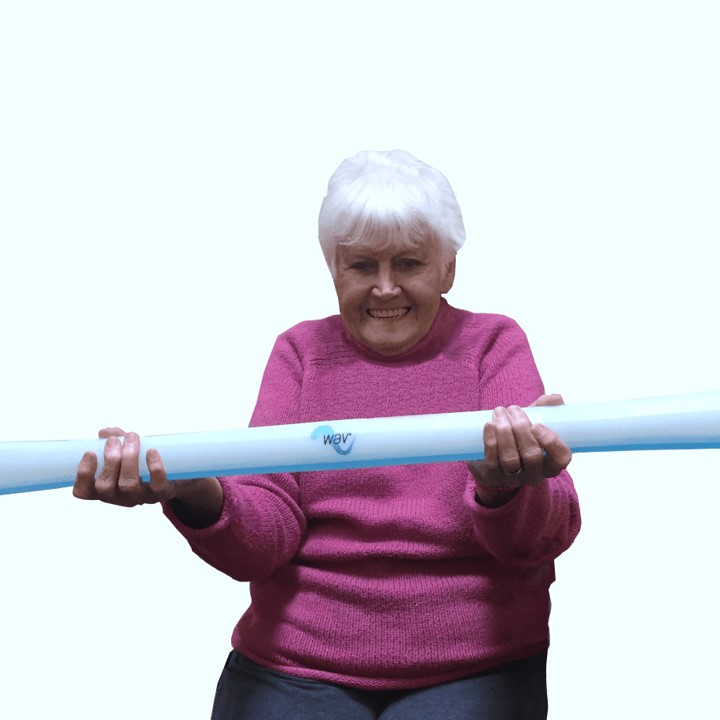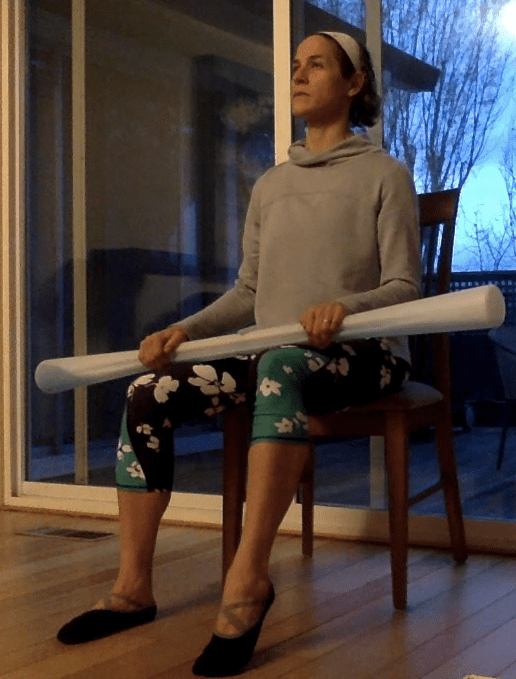Chair Exercises for Older Adults: Keep Moving While You Sit
A body in motion, stays in motion - even when that body happens to be seated. Movement is a necessity for everyone. But how do you take action when you have limited mobility due to the physiological, skeletal or cognitive impairments associated with aging? Chair exercises for older adults can be the answer.
Seated Doesn’t Mean Still
With age, and sometimes injury, sitting may be safer and provide the most functional advantages for exercise. Don’t be fooled, sitting is not a simple act. Multiple systems work together to maintain breathing patterns, postural stability and focus on your environment.
Consequently, older adults (or “mature movers” as we like to say) and the therapists and trainers working with them, often have additional challenges when it comes to movement training. As we age, all systems including the musculoskeletal, neurological, cardiovascular, and cognitive change. Seated exercises provide an accessible way to help prevent physical decline while accounting for these changes.
Research is backing up the notion of exercising in your seat. Several studies have found that adherence to a regular exercise program can improve muscle strength, balance and gait velocity - important factors in minimizing fall risk. In addition, some studies have shown that exercise programs may also enhance cognitive performance and quality of life.
Proof Is In The Posture
An important component of chair exercises for older adults is posture, so let's take a minute to review. There are two types of postures: inactive and active. Inactive postures have minimal muscle activity and promote relaxation. Think of your sleeping or resting positions. Active postures integrate much more muscle activity and coordination of agonist and antagonist muscles.
Sitting is an active posture! Even though the body is still or “quiet,” the body achieves its position by coordination and co-contraction of the postural muscles.
“When we first learned to sit we also learned to use our pelvis and core to actively stabilize our body and our eyes to scan the horizon.”
Remember, the act of sitting upright is a very important developmental milestone for babies. It is when sitting that we begin to navigate the awareness of our pelvis and core to actively stabilize our upper and lower body. It’s also when we learn to use our eyes to search across the horizon and take in our environment. And that skill stays with us through life as we sit in a work environment or a busy restaurant or even when we exercise!
So what is ideal sitting posture? For your upper body, think of good seated posture just like good standing posture. Imagine a string connecting the top of your head to your hips. When you sit or stand, the line of gravity passes through your ear, shoulder, midline of your cervical and lumbar vertebrae and directly through the greater trochanter of your femur. The difference when sitting is that the line changes a bit on the way to the ankle. It continues anteriorly, or forward, to your knee joint and then down to the lateral malleolus of your ankle while the bottom of your foot rests on a stable surface.
Seated Exercises
It’s important to not lose sight of the fact that sitting is an active posture, particularly for those spending prolonged periods of time in the seated position. One of the goals of chair exercises for seniors is to develop the balance and stability needed to maintain ideal seated posture for longer periods of time.
Research shows that chair based exercise (CBE), like the Dynamic Posture Prep described below, can be beneficial for improving things like balance and core strength. In addition to helping combat physical decline, CBE has been cited as an effective way to broaden social interaction for adults in an assisted living or long-term care environments.
“You can still develop core strength and better balance and posture from your chair.”
The benefits of CBE are not reserved only for the mature mover. Seated exercises like the Dynamic Posture Prep, are a perfect midday office break to wake up the body and promote healthy posture. It’s also a good choice for those in early recovery from ankle or knee injury requiring a modified weight bearing load.
The Dynamic Posture Prep is a great training exercise for older adults who may not be able to functionally stand or walk around. It addresses proprioceptive deficits for those whose balance and safety may pose a risk for falls. It’s also applicable more generally for those temporarily requiring a safer, seated position to exercise. It includes foundational concepts for those who are preparing to get back to moving on two feet.
Dynamic Posture Prep
The Dynamic Posture Prep is a two-part seated exercise. The first part of the exercise uses the sensation of the WAV over your knees to help ground your ankles to the floor while stimulating awareness of the distribution of weight through your pelvis. For fun, take note right now while you are reading. Does one ankle or hip feel more heavily weighted to the surface beneath you? Weight distribution is related to the sensibility of “grounding”, which opens the brain-body connection to more axial elongation needed for seated posture.
The second part of the exercise helps create axial elongation with stability throughout the length in the spine from which you are grounded. As your gaze lifts upward and tracks over the WAV, the vestibulospinal reflex (VSR) is reflexively stabilizing the head and engages the rest of your body saying, “Hey! Sit up tall. Look where we are going.” The gaze input and the WAV’s heaviness on the ground stimulates the visual system and somatosensation along with the vestibular system. The result is a whole system approach that elicits more than a vestibular reflex when performing the movement.
If you are ready to advance this move and increase the stability challenge, you can complete this exercise seated on an exercise ball.
When exercising with a new piece of equipment like the WAV, remember it may take some time to learn and practice skills for the technique to be effective. Performing movements in blocked training intervals is helpful to the older adult for both physiological endurance and cognition for learning.
Dynamic Posture Prep
Part 1
Sit with your feet roughly hip width apart. Rest the WAV on your thighs while securing it with your hands.
Lift and lower both of your heels keeping the fluid quiet and level.
Flex both feet to lift the fronts of both feet keeping the fluid quiet and level.
Lift and lower one heel at a time, allowing the liquid in the WAV to gently flow from end to end.
Part 2
Place the WAV in an upright position resting on the ground between your knees.
Walk your hands up the WAV. Follow your “walking” hands with your eyes.
When your hands reach the top of the WAV, pause and use your gaze to search over the height of the WAV, lengthening throughout your spine.
Walk your hands back down the WAV.
What am I doing?
Working on ankle stability and strength.
Learning to ground through your feet.
Creating the length in your spine needed for maintaining a healthy upright position.
Finding your core support and postural alignment in a seated position.
What am I mindful of?
When lifting and lowering your heels, are your toes spread wide while equally weighting all five toes?
Do your ankles move up and down at the same time, keeping even liquid in the WAV?
Can you keep your head, shoulders and hips in alignment as you move your hands up and down? The curvature of the spine does not change, but elongates as the hands move upward.
Are you supporting the WAV with your breath and core?
References for balance, chair based exercise, and posture concepts discussed in this article can be found here:
- George ES, Rosenkranz RR, Kolt GS., Chronic disease and sitting time in middle-aged Australian males: findings from the 45 and Up Study. Int J Behav Nutr Phys Act. 2013 Feb 8;10:20. doi: 10.1186/1479-5868-10-20.
- Kisner C, Colby LA. Therapeutic exercise: foundations and techniques. Fa Davis; 2012 Oct 8.
- Bonnefoy, M., et al.,The effects of exercise and protein–energy supplements on body composition and muscle function in frail elderly individuals: a long-term controlled randomised study. British journal of nutrition 89.5 (2003): 731-738.
- Robinson, Katie R., Tahir Masud, and Helen Hawley-Hague. Instructors’ perceptions of mostly seated exercise classes: exploring the concept of chair based exercise. BioMed research international 2016 (2016).
- Cancela Carral, José M.,Effects of Three Different Chair-Based Exercise Programs on People Older Than 80 Years. Rejuvenation research 20.5 (2017): 411-419.
Want to know more about using the WAV for senior fitness and rehabilitation? Contact us for more information about our sensory-based training approach.





